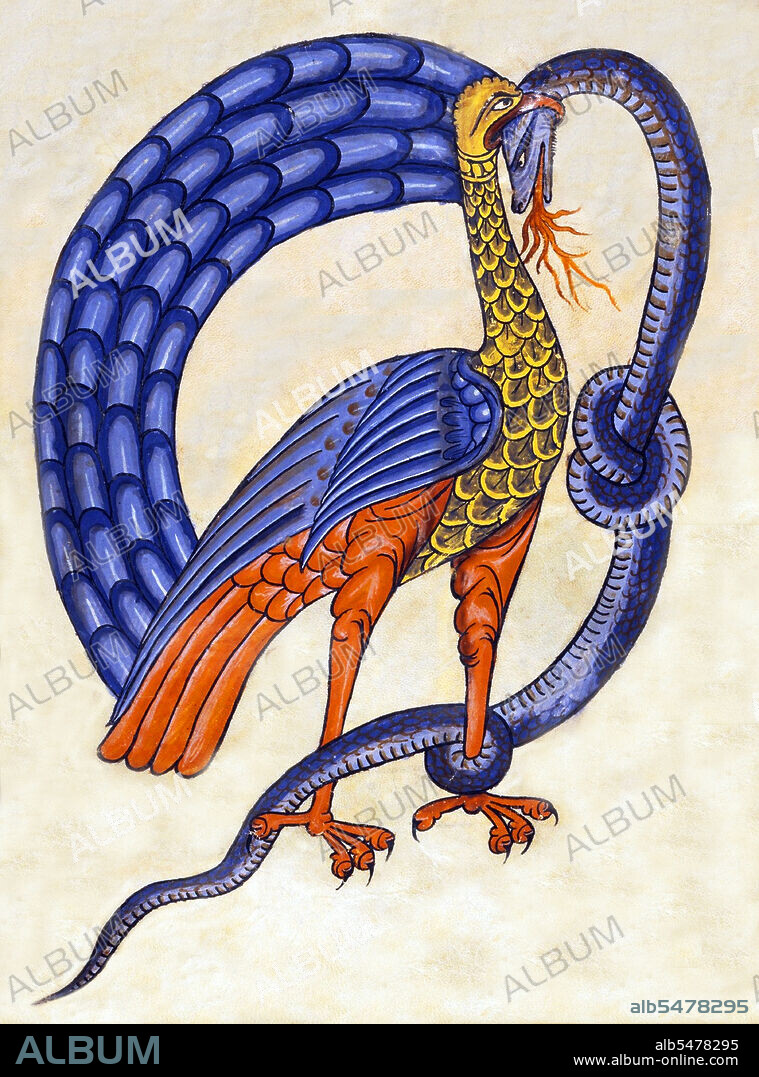alb5478295
Bird (symbol of Christ) killing serpent (symbol of Satan). From a 12th century version of 'The Commentary on the Apocalypse' by Beatus of Liebana.

|
Añadir a otro lightbox |
|
Añadir a otro lightbox |



¿Ya tienes cuenta? Iniciar sesión
¿No tienes cuenta? Regístrate
Compra esta imagen

Título:
Bird (symbol of Christ) killing serpent (symbol of Satan). From a 12th century version of 'The Commentary on the Apocalypse' by Beatus of Liebana.
Descripción:
Traducción automática: El Comentario sobre el Apocalipsis (Commentaria In Apocalypsin) fue originalmente una obra del siglo VIII del monje y teólogo español Beato de Liébana. Hoy en día, se refiere a cualquiera de las copias manuscritas existentes de esta obra, especialmente a cualquiera de las 26 copias iluminadas que han sobrevivido. A menudo se le conoce simplemente como el Beato. La importancia histórica del Comentario se hace aún más pronunciada ya que incluía un mapa mundial, que ofrece una visión poco común de la comprensión geográfica del mundo posromano. Entre las copias más conocidas se encuentran los códices Beatus de Morgan, Saint-Sever, Gerona, Osma y Madrid (Vitr 14-1). Considerados en conjunto, los códices Beatos se encuentran entre los manuscritos medievales españoles más importantes y han sido objeto de una extensa investigación académica y anticuaria.
Commentary on the Apocalypse (Commentaria In Apocalypsin) was originally an eighth century work by the Spanish monk and theologian Beatus of Liebana. Today, it refers to any of the extant manuscript copies of this work, especially any of the 26 illuminated copies that have survived. It is often referred to simply as the Beatus. The historical significance of the Commentary is made even more pronounced since it included a world map, which offers a rare insight into the geographical understanding of the post-Roman world. Well-known copies include the Morgan, the Saint-Sever, the Gerona, the Osma and the Madrid (Vitr 14-1) Beatus codices. Considered together, the Beatus codices are among the most important Spanish medieval manuscripts and have been the subject of extensive scholarly and antiquarian enquiry.
Crédito:
Album / Pictures From History/Universal Images Group
Autorizaciones:
Modelo: No - Propiedad: No
¿Preguntas relacionadas con los derechos?
¿Preguntas relacionadas con los derechos?
Tamaño imagen:
3600 x 4858 px | 50.0 MB
Tamaño impresión:
30.5 x 41.1 cm | 12.0 x 16.2 in (300 dpi)
Palabras clave:
ANTIGUO TESTAMENTO • APOCALIPSIS • AVE • AVES • BIBLIA • BIBLICA • BÍBLICO • BÍBLICOS • CHRISTIAN • CRISTIANA • CRISTIANAS • CRISTIANO • CRISTIANOS • CRISTO • ESPAÑA • ESPAÑOL • ESPAÑOLA • ESPAÑOLES • HISTORIA • HISTORICO • ILUMINACION • JESUS • LIBRO DE LA REVELACION • NUEVO TESTAMENTO • PAJARO • PINTURA • RELIGION • RELIGION: CRISTIANA • SAN JUAN • SERPIENTE • SERPIENTES SERPIENTE • SNAKE • SPAIN • VIEJO TESTAMENTO
 Pinterest
Pinterest Twitter
Twitter Facebook
Facebook Copiar enlace
Copiar enlace Email
Email
